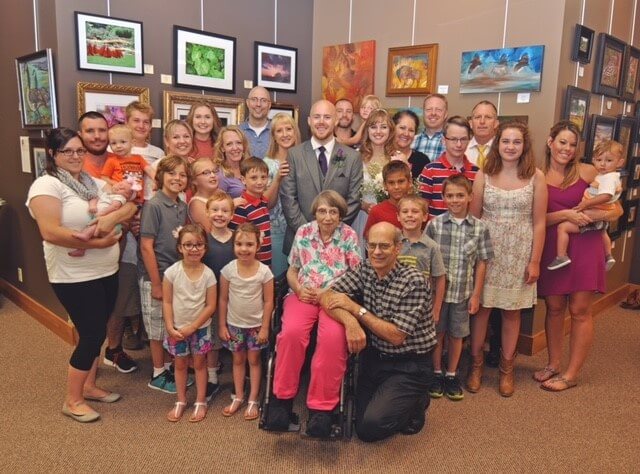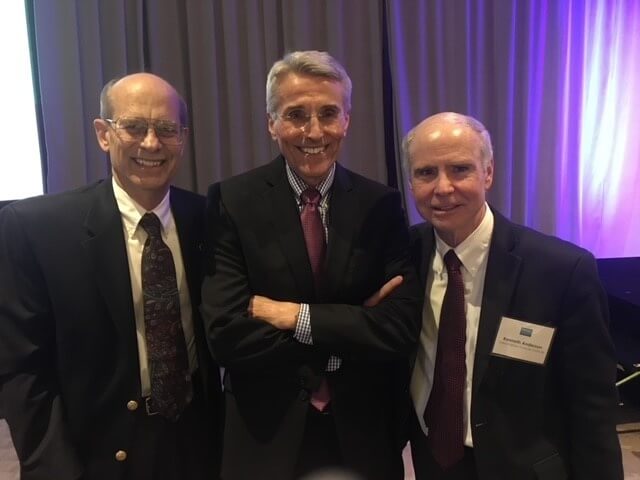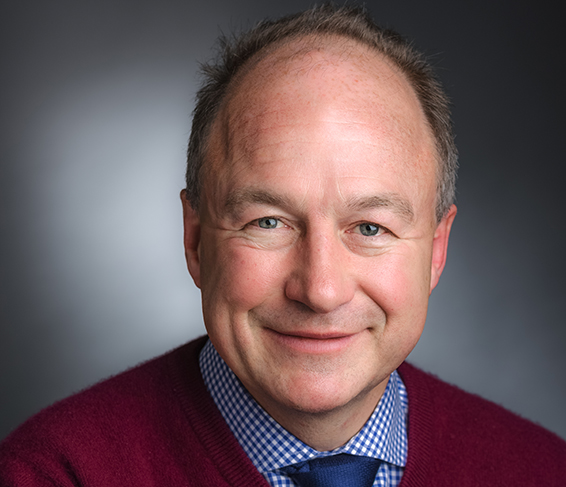Jim Omel, MD, helped many cancer patients during his long career as a family physician, and that has not changed since his own 1997 diagnosis with multiple myeloma. What has changed is the reach of his support.
While Omel, 77, cared for primarily farming families near his Nebraska clinic during 25-plus years in practice, his efforts as a multiple myeloma advocate in recent decades have benefited people worldwide. His deep understanding of this incurable blood cancer that develops in the bone marrow — what causes it, how best to treat it, and how to live with it — has made him an invaluable resource both to patients as well as to researchers and physicians devising new clinical trials.

So when Paul G. Richardson, MD, and Kenneth C. Anderson, MD, in the Jerome Lipper Multiple Myeloma Center at Dana-Farber led with their colleagues the landmark DETERMINATION Study – a clinical trial testing the benefits and risks of autologous stem cell transplants for patients with newly diagnosed multiple myeloma across the country – they sought Omel’s counsel as both a colleague and patient advocate. They recognized that Omel’s insights, borne of his unique experience as a patient, transplant recipient, and physician, would be beneficial to the study, in particular his having served on the Alliance Myeloma Committee as part of the National Intergroup for clinical trials. Accordingly, they invited Omel to speak at patient seminars and research meetings in support the trial when it was first activated and then continued across the U.S.
“Jim’s contribution was invaluable,” says Richardson, clinical program leader and director of clinical research in the Jerome Lipper Multiple Myeloma Center at Dana-Farber. “His enthusiasm coupled with a keen intelligence, as well as true compassion for patients, directly impacted on the success of the trial, which in turn strengthened our ability to inform practice, and now next steps.”
Instrumental insights
Remarkably, the DETERMINATION study enrolled 722 patients at Dana-Farber and 55 other cancer centers nationwide — including the largest African American accrual (18% of participants) of any similar myeloma treatment study to date. African Americans have twice the risk of whites of developing multiple myeloma, and the large number of diverse enrollees enabled Richardson and his team to conduct a subgroup analysis comparing the benefits of early versus later stem cell transplants in African American and white participants in the DETERMINATION study.
Among the findings: African American patients in general did not derive as much progression-free survival benefit from an early transplant coupled with the use of high doses of the powerful chemotherapy drug melphalan. Importantly, when compared to white patients receiving identical treatment, African American patients appeared to derive more benefit from a less intensive approach using the triple of lenalidomide, bortezomib and dexamethasone (so-called RVd).
“DETERMINATION has provided a unique platform to inform patients around choices in the newly diagnosed setting of transplant-eligible patients, as well as establishing a much more tailored approach to care where clearly one size doesn’t fit all,” says Richardson. “Achieving the highest African American participation in this setting to date was particularly important in identifying differences in outcome based on pathobiology and not just access to best care. Jim’s patient advocacy as well as our coordinated efforts to improve African American patient participation proved key in making this happen.”
Dangerous self-diagnosis
A Nebraska native, Omel had little experience with multiple myeloma in his family practice. While the second most common blood cancer after non-Hodgkin’s lymphoma, it is still considered a relatively rare disease — although its incidence is increasing.
“As a doctor I treated whatever came in the door, from gunshot wounds and heart attacks to children’s rashes,” Omel explains. “There were plenty of cancer cases, but only two patients with multiple myeloma in 25 years. Both died soon after their diagnosis.”
Omel knew that a persistent backache is often an early warning sign of multiple myeloma, but when he began experiencing this symptom himself in 1997, he initially attributed it to another cause.
“My wife, Pat, had multiple sclerosis, and as it progressed, she needed me to help lift or rotate her during the day and get her into bed at night,” recalls Omel. “I assumed I had strained my back from lifting her incorrectly and not exercising properly.”
It was not until the pain grew intolerable that Omel had an MRI. It showed that the bones of the 10th thoracic vertebrae in his mid-back had broken into pieces, and a needle biopsy confirmed multiple myeloma as the cause.

“I had let nine months pass since my back problems started, and I was devastated,” Omel explains. “There is a simple test called a serum protein electrophoresis, or SPE, that measures if there is too much immunoprotein is in your blood. I’ve since become committed to reminding doctors to perform tests like SPE and urine protein electrophoresis for patients exhibiting pain deep in their bones.”
Omel’s cancer was put into temporary remission by chemotherapy and radiation, and he resumed his family practice. A recurrence in 2000, however, showed lesions forming in several additional bones in his body. He had a stem cell transplant, retired from his practice, and focused on caring for Pat (who passed away in 2018) and enjoying time with their four children and a growing brood of grandchildren and great-grandchildren.
Determined to help
It was a wonderful life, Omel says, but he longed to continue helping others. Advocacy was the answer. Omel has since served on committees with the National Cancer Institute, International Myeloma Foundation, and the U.S. Food and Drug Administration. He has also written numerous journal articles on multiple myeloma and spoken to many individuals and organizations to raise awareness about the genetic abnormalities and warning signs for the disease.

It was in this capacity that Omel bonded with Richardson and Anderson while serving with the Alliance Myeloma Committee and other groups. The personal connections he made with patients while leading a myeloma support group gave Omel additional insight into their needs, a perspective he used when consulting on the DETERMINATION study and other clinical trials.
“Jim has turned his own illness into hope and life for all patients,” says Anderson, director of the Jerome Lipper Multiple Myeloma Center at Dana-Farber. “His decades-long journey and heartfelt comments from a patient perspective have directly helped to design clinical trials, transform the treatment paradigm, and assure patient access to these advances. Jim serves as a hero and inspiration, a wonderful example of people taking care of each other and the importance of patient advocacy to fast-forward progress in medicine.”
It is a role Omel not only relishes, but one he is determined to pass on.
“I hate myeloma, but it has given me the chance to help thousands of patients, both individually and collectively,” says Omel. “I am at 27 years of survivorship and counting, still helping patients and mentoring new research advocates so that they can be effective in helping patients too.”
About the Medical Reviewer

After certification in Internal Medicine, Hematology and Medical Oncology, as well as working in Cancer Pharmacology from 1994 onwards at Dana-Farber Cancer Institute (DFCI), Dr. Paul Richardson joined the Jerome Lipper Myeloma Center in 1999, was appointed Clinical Director in 2001, and led the development of several first-generation novel drugs including bortezomib, lenalidomide and pomalidomide for the treatment of multiple myeloma. Subsequent studies have focused on next-generation novel drugs including panobinostat and second-generation proteasome inhibitors including ixazomib. More recently, his clinical innovations have been in the development of the breakthrough monoclonal antibodies elotuzumab and daratumumab for the treatment of both untreated and relapsed myeloma, as well as isatuximab and more broadly, antibody drug conjugates including belantamab mafodotin, as well as other immunotherapeutic strategies. In addition to these agents, he is leading the development of melflufen, a targeted cytotoxic and a first-in-class small molecule inhibitor selinexor, which inhibits XPO-1, a key nuclear export protein, as well as first-in-human studies of cereblon E3 ligase modulators (so called CELMoDs) for the treatment of relapsed and refractory myeloma. Over the last decade, his major effort has been focused on the development of lenalidomide, bortezomib and dexamethasone (so-called RVD), and its incorporation as part of the Intergroup Francophone Myelome (IFM)/DFCI clinical trial in newly diagnosed patients eligible for stem cell transplant treated with RVD. This regimen has generated an unprecedented response rate, leading to its adoption in this international study, as well as others in the United States and elsewhere. This particular trial incorporates genomic and proteomic evaluation to establish a future platform for tailored therapy and the optimal positioning of stem cell transplant, with results anticipated in 2021-22. Furthermore, RVD has been established as a backbone to which next-generation agents are being added, including elotuzumab, daratumumab and isatuximab, as well as panobinostat. He has published extensively, having authored or co-authored over 400 original articles and 330 reviews, chapters, and editorials in peer-reviewed journals. In addition to holding positions on the Editorial Boards of leading journals, he is prior Chairman of the Multiple Myeloma Research Consortium (MMRC), Clinical Trials Core, a position held for 5 years as part of a rotating tenure, and for which he continues as a member of the Steering and Project Review Committee. He was also a member of ASCO Hematologic Malignancies Subcommittee for the required one-year term, and then for one year on the ASCO Internet Cancer Information Committee during 2017. He was appointed Chair of the Alliance Myeloma Committee in 2011 and continues in this role. Honors include the George Canellos Award for Excellence in Clinical Research and Patient Care, and The Tisch Outstanding Achievement Award for Clinical Research, as well as an honorary Fellowship of the Royal College of Physicians (UK), given in recognition for international contributions in multiple Myeloma and stem cell transplantation. He was a co-recipient of the prestigious Warren Alpert Foundation Prize in recognition of the successful therapeutic targeting of the ubiquitin-proteasome pathway in 2012. He was also a co-recipient of the Accelerator Award for contributions to clinical research and patient enrollment in MMRC studies, as well as for the Research Center of the Year Award in 2009, followed by the second award for Center of the Year in 2017. He was ranked by Thomson Reuters Science Watch amongst the top 19 investigators at DFCI for the most highly cited research in 2016. He was the co-recipient of the ASH Ernest Beutler Prize for clinical science and translational research in the development of proteasome inhibition as an effective treatment strategy for multiple myeloma in 2015; the COMY Award for MM research (Paris, France) in 2016, and the prestigious IMF Robert A. Kyle Lifetime Achievement Award in 2017, and the Morse Research Award in 2019.
